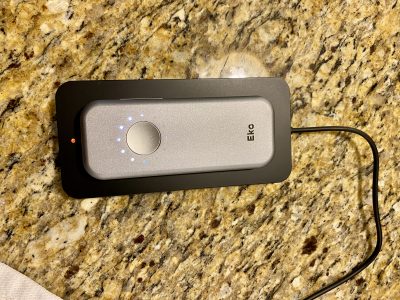Yes, decidedly:
via JAMA:

The interesting parts of the explanation:
…In 2004, more ED visits included imaging procedures than in 1995 (43% versus 38% of visits, respectively). During 1995-2004, the number of MRI or CAT scans nearly quadrupled, and the number of ultrasounds more than doubled. The overall number of ED visits increased by 14%.
I see this as more access to technology more than anything else. The rule today: if there’s a test for it, just get the test.




I’m not going to say it’s all good, but in many cases getting a CT or MRI will avoid a hospitalization for “observation”, which in many cases translates into having the patient hang around to see if something bad will happen, and of course we can’t REALLY just do nothing, so more meaningless tests are ordered.
Interesting, but don’t you think that has a lot to do with medico-legal issues.
I am a urologist and often order tests in the ED on my patients more for legal issues and worried about the 1 in a million what if then for medical reasons.
I hate to say it but I think X-rays and CT’s are frequently ordered due to a lack of time or effort – the doc doesn’t have the time to do a very thorough exam so orders a CT to make sure nothing really bad is going on. Possibly this is a result of increased ER utilization over the years?
Goatwhacker, how does a thorough exam exclude hydronephrosis, or subdural, or ovarian torsion? Or even most cases of appendicitis?
We order more scans because they’re quick and effective, and they help prevent bad outcomes. Radiology makes emergency medicine safer.
Bad Shift, if you’re ordering CT’s with the idea of looking for those things, that’s great and an appropriate usage of the CT. What I’m talking about is tests that are ordered to essentially substitute for an H&P because the doc doesn’t have the time or inclination to perform one. I wish it didn’t happen at our hospital but it does. One of our radiologists refers to radiology as the new triage department.
It bugs me when an ER doc is able to rattle off all the test results but isn’t sure how the patient feels, or what the physical exam showed.
I didn’t mean to offend anyone.
You should really correlate this stat to how the numbers of malpractice lawsuits in 2004 compared to 1995, and the $$$ awarded.
It’s food for thought. I agree that improved access to imaging is a big factor. But I keep coming back to appendicitis: I rarely ordered CT or sonogram because I felt the diagnosis can most often be made clinically. I ordered it when something didn’t fit. But it’s become virtually routine now, and surgeons are complicit. They’d rather not come see the patient until the diagnosis is made. Can’t say I blame them, given the time/reimbursement/call issues we all face. But in a more perfect world….
CT are US are relatively painless, and far from simply being academic, they provide information that can dramatically change your management. Why wouldn’t we expect increased utilization of useful diagnostic modalities? Also, any surgery has a set of risks all its own, including anesthesia risks. Can you blame the surgeons for trying to decrease their negative lap rate with CT?
And just as a counter-point to Goatwhacker’s experience, I always do at least one exam before I bundle somebody off to the radiology dept (sometimes multiple exams, depending on the patient).
I use CT and US (and yes, even MRI) liberally when I think they’re going to help me in my management; I make no apologies for doing so.
“And just as a counter-point to Goatwhacker’s experience, I always do at least one exam before I bundle somebody off to the radiology dept (sometimes multiple exams, depending on the patient).”
Good for you. In our ER’s the docs just have the nurses do all the preliminary ordering and, predictably, they end up ordering a lot of useless exams.
From the ED point of view:
If you’re a consultant at a place where the ED docs don’t see patients before the patient goes to CT, etc, it’s time to go to the hospital administration and ask for better performance, but there’s a catch.
The contract most likely wasn’t negotiated by the docs in the ED, and they’re probably working as hard and as fast as they safely can, but their pay / staffing structure isn’t set by them, so don’t blame the faces you see. This is the fault of the EM staffing company (most likely) and the hospital, trying to get as much as they can for as little as possible that winds up with this scenario. (Hospital makes a bad contract to save money, winds up with a lot of expensive unreimbursed tests as a result of false economies. Discuss.)
So, if this is happening, please a) do something about it and b) don’t blame the guy in the trenches.
That’s a pretty self-serving recommendation. If the ER is understaffed then the ER docs need to address the problem with administration but still do the right thing until help arrives. There is no excuse for nurses ordering tests on their own that require a physician order.
Self-serving how?
You don’t understand that the vast majority of hospitals don’t consider their EM docs part of the medical staff really, they’re just assets to have and dump when they cause problems, like complain about staffing ratios.
As for having nurses order exams, that’s SOP in a lot of ED’s, covered by Standing Orders. Not a perfect world, but one that works.
“You don’t understand that the vast majority of hospitals don’t consider their EM docs part of the medical staff really, they’re just assets to have and dump when they cause problems, like complain about staffing ratios.”
Man, isn’t that the truth. The administration just wants the ED docs to toil in benign obscurity, regardless of real issues; the medical staff want us to never ever contact them regardless of need; and the patients want us to give them all the answers, regardless of objective data or lack thereof. The greasy wheel ED is one that may have a very short contract life, indeed.
Well you can rationalize it all you want but it is just bad medicine for nurses to be ordering imaging tests with no input from the ER doc.
I’m not rationalizing anything, I’m trying to explain it’s a common practice. And, the docs have a big part in that practice.
The standing orders most ED’s have are pretty restrictive, and are flow-chart type. They’re agreed upon at least by the nurses and the ED docs, and sometimes they have to be approved by the hospital’s medical staff.
So, it’s not just ‘nurses gone wild’ ordering tests, there’s a reason for it.
Nurses ordering sophisticated imaging tests without a physician’s input is just plain bad medicine, no matter what the root cause. This is just undeniable.